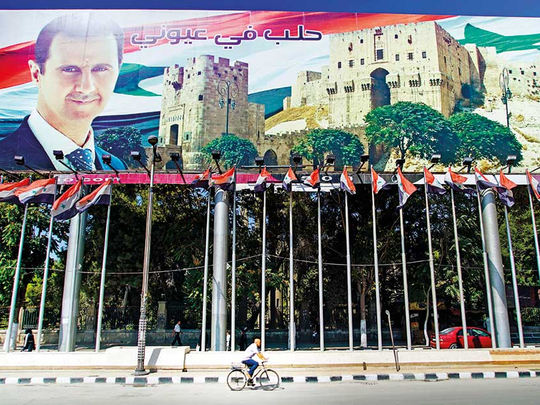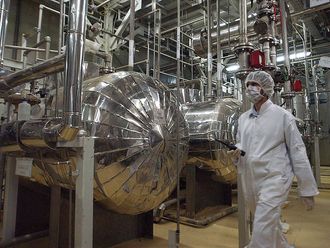
Beirut: With his political survival all but assured, Syria’s President Bashar Al Assad and his wife, Asma, are back to acting presidential, making bread at a bakery in Hama province, checking out a dairy in Tartus, and comforting wounded soldiers at their home.
After six years of civil war, the images of a beaming, confident Al Assad are meant to telegraph his ability to defy predictions that his ouster was only a matter of time. But they can’t paper over the fact that the Syrian leader has emerged from this power struggle much weakened, heading a country possibly broken beyond repair.
The Syria he once ruled with an iron grip is now fractured into volatile fiefdoms, its citizenry ravaged, its infrastructure decimated, its insurgencies likely to smolder even after the conflict officially ends. He controls only half of the country, and after the war, will have to share authority with other players, including autonomy-seeking Kurds, and Russia and Iran, whose militaries shored him up.
“The Syria we knew is not the Syria that will come back,” said Maha Yahya, director of the Carnegie Middle East Centre. “They’ve changed irrevocably. For Al Assad, the battle is not completely over.”
Al Assad himself acknowledged the massive challenges ahead, even as he blamed his country’s turmoil on the West.
“Talking about foiling the Western project in the region doesn’t mean we are victorious,” he said at a government event last month. “They have failed, but the battle is still going on.”
When Syria’s conflict began in March 2011, at the height of the Arab Spring revolts, many expected Al Assad to be overthrown like other regional leaders. Gulf countries shut embassies and withdrew financial support, and European leaders called for his departure. Barack Obama, then the US president, warned of red lines.
But Al Assad prevailed over setbacks, helped by the opposition’s fragmentation and radicalisation, and Russia’s entry into the war on his behalf in late 2015, said David Butter, associate fellow at Chatham House in London.
The half of Syria he now controls is home to major cities, more than two-thirds of the population and several gas fields, according to Rami Abdurrahman, head of the UK-based Syrian Observatory for Human Rights, which monitors the war through activists on the ground. Government troops recently broke the three-year siege of Deir Al Zor in the east, moving close to oil deposits.
The rest of the country is controlled by Kurdish separatists and a proliferation of armed groups - including Daesh, an Al Qaida affiliate, fighters backed by the West and Turkey - suggesting that violence will continue to dominate Syria’s future, even if a settlement is reached.
Al Assad’s piecemeal gains represent “a very fragmented approach,” Yahya said. “It’s one that’s likely to reduce the intensity of violence and maybe stabilise a little bit, but medium to long term it’s very fragile.”
Even in the areas he controls, Al Assad’s position has been weakened, with wartime allies Russia and Iran becoming major players in Syria’s military, diplomatic and economic affairs, including peace talks.
“Al Assad owes them his survival and he has to deal with foreign armies on the ground,” said Sami Nader, head of the Beirut-based Levant Institute for Strategic Affairs. “Russia and to a lesser extent Iran are doing big Syria politics by striking deals with other players, irrespective of how the Al Assad regime feels about it.”
Iran’s deepening presence in Syria has also raised the risk of confrontation with neighboring Israel. Israel says top foe Iran and its allies are digging in across its frontier with Syria to position themselves to attack, and has warned it won’t tolerate the threat. Just last week, Damascus blamed the Israeli air force for last week’s unclaimed strike on a military facility.
Putting Syria back together after so much violence will be a staggering, if not impossible task complicated by Al Assad’s continued rule. Nearly half a million people have been killed, according to SOHR, and half of the prewar population of 23 million has been displaced in the biggest refugee crisis since World War II, according to the United Nations.
The economy lost $226 billion in gross domestic product between 2011 and the end of 2016, or about four times 2010 output, according to the World Bank. Hundreds of thousands of homes have been damaged or destroyed, electricity supply is spotty in major cities, and youth unemployment has soared to 78 per cent, according to the bank.
Al Assad last year estimated the economic damage from the war at more than $200 billion. But although the scale of destruction is so vast, big donors won’t be rushing to send reconstruction money, analysts said.
They’re “very concerned to put money in ways that will end up enabling the regime that is responsible for all the atrocities we know of,” Yahya said.
Instead of “coherent programs, big money tied up with the World Bank and big companies,” expect smaller-scale reconstruction projects and trade pacts, Butter added. Syria’s first international trade fair in five years last month offered a taste of what may come: Egypt agreed to buy apples, India may set up a pharmaceutical company and Iraq signed million-dollar contracts.In the meantime, state-controlled media are celebrating small victories. SANA news agency reported that 400 factories have returned to production in Aleppo, the long-besieged prewar commercial hub. It carried pictures of Syrians enjoying a festival in the resort town of Bloudan and an exhibition in Damascus called “State of Love Q1.”
“As we slowly inch back to the light, we grasp at whatever can restore the pulse to our lives, so we can live with dignity and peace,” Syrian actress Rana Shmeis said after winning the best actress award at Iraq’s film festival in August.











